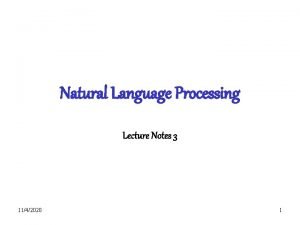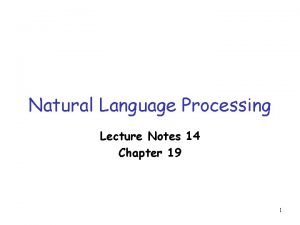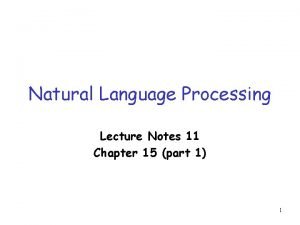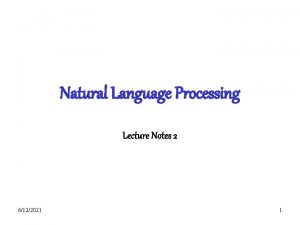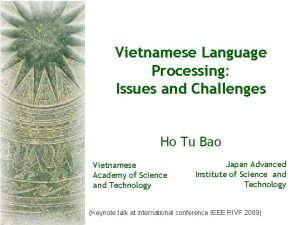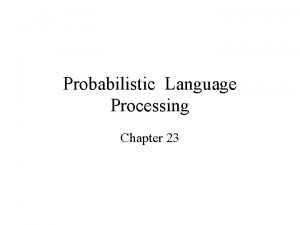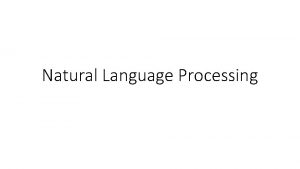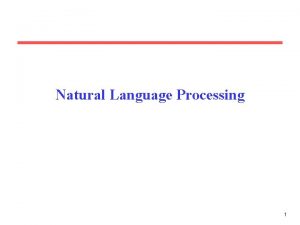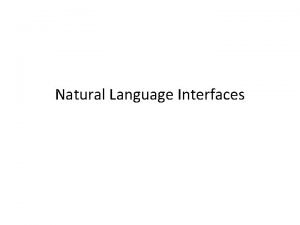Lecture 13 NLP Natural Language Processing Deanship of









- Slides: 9


Lecture 13 NLP Natural Language Processing ﻋﻤﺎﺩﺓ ﺍﻟﺘﻌﻠﻢ ﺍﻹﻟﻜﺘﺮﻭﻧﻲ ﻭﺍﻟﺘﻌﻠﻴﻢ ﻋﻦ ﺑﻌﺪ Deanship of E-Learning and Distance Education [ 2 ] ﺟﺎﻣﻌﺔ ﺍﻟﻤﻠﻚ ﻓﻴﺼﻞ King Faisal University

The Problem of Syntactic Analysis Assume input sentence S in natural language L Assume you have rules (grammar G) that describe syntactic regularities (patterns or structures) found in sentences of L Given S & G, find syntactic structure of S Such a structure is called a parse tree ﻋﻤﺎﺩﺓ ﺍﻟﺘﻌﻠﻢ ﺍﻹﻟﻜﺘﺮﻭﻧﻲ ﻭﺍﻟﺘﻌﻠﻴﻢ ﻋﻦ ﺑﻌﺪ Deanship of E-Learning and Distance Education [ ] ﺟﺎﻣﻌﺔ ﺍﻟﻤﻠﻚ ﻓﻴﺼﻞ King Faisal University

Example 1 S S NP VP VP V NP I NP he V slept V ate V drinks NP he VP V slept Grammar ﻋﻤﺎﺩﺓ ﺍﻟﺘﻌﻠﻢ ﺍﻹﻟﻜﺘﺮﻭﻧﻲ ﻭﺍﻟﺘﻌﻠﻴﻢ ﻋﻦ ﺑﻌﺪ Deanship of E-Learning and Distance Education Parse Tree [ ] ﺟﺎﻣﻌﺔ ﺍﻟﻤﻠﻚ ﻓﻴﺼﻞ King Faisal University

More Complex Sentences I can fish. I saw the elephant in my pajamas. These sentences exhibit ambiguity Computers will have to find the acceptable or most likely meaning(s). ﻋﻤﺎﺩﺓ ﺍﻟﺘﻌﻠﻢ ﺍﻹﻟﻜﺘﺮﻭﻧﻲ ﻭﺍﻟﺘﻌﻠﻴﻢ ﻋﻦ ﺑﻌﺪ Deanship of E-Learning and Distance Education [ ] ﺟﺎﻣﻌﺔ ﺍﻟﻤﻠﻚ ﻓﻴﺼﻞ King Faisal University

Meaning from a Parse Tree I can fish. We want to understand Who does what? the canner is me, the action is canning, and the thing canned is fish. e. g. Canning(ME, Fish. Stuff) This is a logic representation of meaning We can do this by associating meanings with lexical items in the tree • then using rules to figure out what the S as a whole means • ﻋﻤﺎﺩﺓ ﺍﻟﺘﻌﻠﻢ ﺍﻹﻟﻜﺘﺮﻭﻧﻲ ﻭﺍﻟﺘﻌﻠﻴﻢ ﻋﻦ ﺑﻌﺪ Deanship of E-Learning and Distance Education [ ] ﺟﺎﻣﻌﺔ ﺍﻟﻤﻠﻚ ﻓﻴﺼﻞ King Faisal University

Meaning from a Parse Tree (Details) Let’s augment the grammar with feature constraints S NP VP [subj: *1 pred: *2 obj: *3] [pred: *2 obj: *3] *1[sem: ME] <S subj> =<NP> <S>=<VP> VP V NP *3[sem: Fish Stuff] *2: [pred: Canning] <VP> = <V> <VP obj> =<NP> ﻋﻤﺎﺩﺓ ﺍﻟﺘﻌﻠﻢ ﺍﻹﻟﻜﺘﺮﻭﻧﻲ ﻭﺍﻟﺘﻌﻠﻴﻢ ﻋﻦ ﺑﻌﺪ Deanship of E-Learning and Distance Education [ ] ﺟﺎﻣﻌﺔ ﺍﻟﻤﻠﻚ ﻓﻴﺼﻞ King Faisal University

Grammar Induction Start with a tree bank = collection of parsed sentences Extract grammar rules corresponding to parse trees, estimating the probability of the grammar rule based on its frequency P(A β | A) = Count(A β) / Count(A) You then have a probabilistic grammar, derived from a corpus of parse trees How does this grammar compare to grammars created by human intuition? How do you get the corpus? ﻋﻤﺎﺩﺓ ﺍﻟﺘﻌﻠﻢ ﺍﻹﻟﻜﺘﺮﻭﻧﻲ ﻭﺍﻟﺘﻌﻠﻴﻢ ﻋﻦ ﺑﻌﺪ Deanship of E-Learning and Distance Education [ ] ﺟﺎﻣﻌﺔ ﺍﻟﻤﻠﻚ ﻓﻴﺼﻞ King Faisal University

 Natural language processing nlp - theory lecture
Natural language processing nlp - theory lecture Natural language processing nlp - theory lecture
Natural language processing nlp - theory lecture Natural language processing lecture notes
Natural language processing lecture notes Natural language processing lecture notes
Natural language processing lecture notes Natural language processing lecture notes
Natural language processing lecture notes Natural language processing lecture notes
Natural language processing lecture notes Nlp lecture notes
Nlp lecture notes Natural language processing vietnamese
Natural language processing vietnamese Probabilistic model natural language processing
Probabilistic model natural language processing Markov chain natural language processing
Markov chain natural language processing



